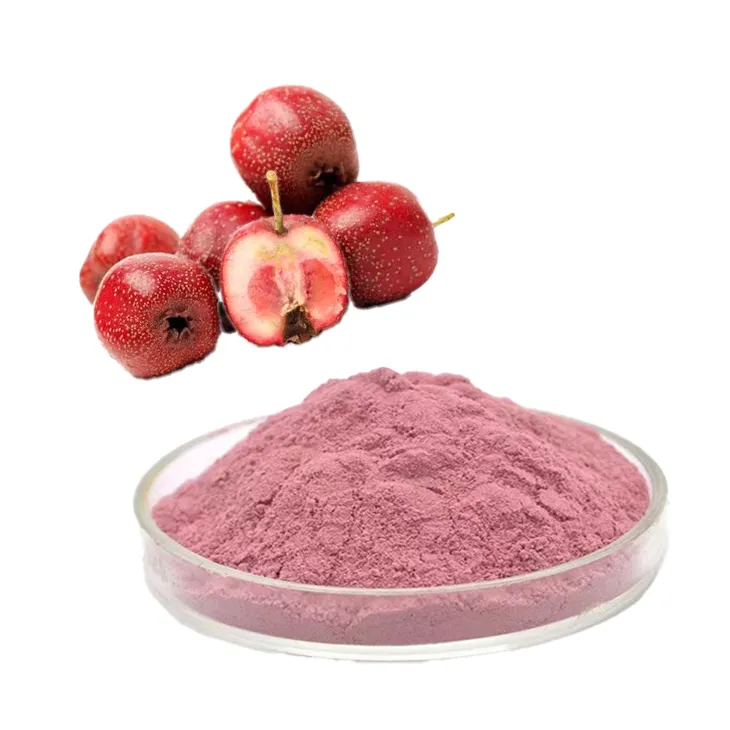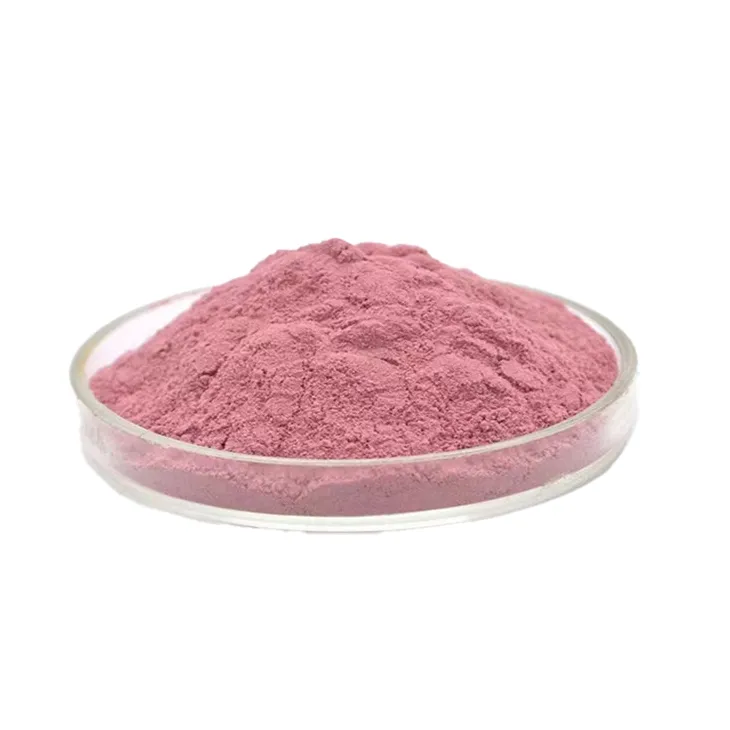- 0086-571-85302990
- sales@greenskybio.com
The Best Types of Hawthorn Powder: A Guide to Choosing the Best Hawthorn Powder
2024-11-12

Introduction
Hawthorn powder has been gaining popularity in recent years due to its numerous health benefits. Derived from the hawthorn fruit, this powder can be used in various ways, such as in cooking, making herbal teas, or as a dietary supplement. However, with the increasing availability of Hawthorn powder in the market, it can be quite challenging to choose the best one. This article aims to provide a comprehensive guide on how to select the top - notch Hawthorn powder by considering crucial factors like the origin of the hawthorn, processing techniques, and its diverse applications.

1. Understanding Hawthorn
1.1 Botanical Features
Hawthorn is a genus of shrubs and trees in the family Rosaceae. The fruits of hawthorn are typically small, round or oval - shaped, and range in color from red to orange - red. They are rich in nutrients such as flavonoids, phenolic acids, and vitamins. These components contribute to the potential health - promoting properties of hawthorn powder.
1.2 Geographic Distribution
Hawthorn species are widely distributed across the globe. They can be found in North America, Europe, and Asia. The origin of the hawthorn can significantly influence the quality of the resulting powder. For example, hawthorn from certain regions may be exposed to less pollution and more favorable growing conditions, which could result in a higher - quality product.

2. Origin of Hawthorn: A Key Factor
2.1 European Hawthorn
- European hawthorn (Crataegus monogyna) is one of the most well - known species. It has a long history of use in traditional European medicine.
- The regions where it is grown, such as in parts of France, England, and Germany, often have a temperate climate. This climate can contribute to the development of high - quality fruits with a rich flavor profile and a high concentration of beneficial compounds.
- Hawthorn powder made from European hawthorn may be preferred for its traditional use and the reputation of the European regions for strict agricultural and quality control standards.
2.2 Asian Hawthorn
- In Asia, various hawthorn species are cultivated, with Crataegus pinnatifida being a prominent one in China. China has a vast area suitable for hawthorn growth, including mountainous regions.
- Asian hawthorn is often used in traditional Chinese medicine. The unique growing environment in Asia, with its distinct soil types and climate patterns, can endow the hawthorn with different chemical compositions compared to European hawthorn.
- Hawthorn powder from Asian sources may offer different health benefits and flavor characteristics, making it an attractive option for those interested in traditional Asian medicine or unique taste experiences.
2.3 North American Hawthorn
- North America is home to several hawthorn species as well. These hawthorns are adapted to the local ecosystems, which can range from temperate forests to more arid regions.
- The native North American hawthorn species may have evolved unique chemical defenses and nutritional profiles due to their specific environmental pressures.
- Hawthorn powder sourced from North America could potentially provide a different set of health benefits and may appeal to consumers who prefer products from local or native sources.

3. Processing Techniques and Their Impact
3.1 Drying Methods
- Air - drying is a traditional method. It is a slow process that allows the hawthorn fruits to gradually lose moisture while retaining their natural flavors and nutrients to a large extent.
- However, it requires careful control of environmental conditions such as temperature and humidity to prevent mold growth. If not done properly, it can lead to a lower - quality product.
- Another method is freeze - drying. This modern technique involves freezing the hawthorn fruits and then removing the moisture under vacuum conditions. Freeze - drying can better preserve the volatile compounds in hawthorn, resulting in a powder with a more intense flavor and higher nutrient retention.
3.2 Grinding and Milling
- The fineness of the grind is an important aspect. A finer grind can result in a more homogeneous powder that is easier to mix and dissolve, especially when used in beverages or cooking.
- High - quality milling equipment should be used to ensure that the particles are evenly sized and that there is no excessive heat generation during the grinding process, as excessive heat can degrade the nutrients in the hawthorn powder.
3.3 Quality Control during Processing
- Reputable manufacturers will conduct regular quality control checks. These checks may include testing for contaminants such as pesticides, heavy metals, and microbial organisms.
- They will also ensure that the processing parameters are consistent to produce a uniform product in terms of quality, flavor, and nutrient content.

4. Nutritional Content and Health Benefits
4.1 Flavonoids
- Hawthorn powder is rich in flavonoids, such as Quercetin, rutin, and hyperoside. These flavonoids have antioxidant properties, which can help protect the body's cells from oxidative stress caused by free radicals.
- They may also contribute to cardiovascular health by improving blood vessel function, reducing inflammation, and helping to regulate blood pressure.
4.2 Phenolic Acids
- Phenolic acids present in hawthorn powder, like chlorogenic acid, play a role in its antioxidant and anti - inflammatory activities.
- These compounds may also have potential benefits for digestive health, such as promoting a healthy gut microbiota and reducing the risk of certain gastrointestinal disorders.
4.3 Vitamins and Minerals
- Hawthorn contains vitamins such as vitamin C, which is important for immune function, collagen synthesis, and antioxidant protection.
- It also contains minerals like potassium, which is involved in maintaining proper heart and muscle function.
5. Applications of Hawthorn Powder
5.1 Culinary Uses
- Hawthorn powder can be used in baking. It can be added to muffin or cake batters to give a unique flavor. The slightly tart flavor of hawthorn can add a pleasant contrast to sweet baked goods.
- In cooking, it can be used in sauces, such as fruit - based sauces for meats. It can enhance the flavor profile and add a touch of acidity.
- It can also be used to make hawthorn - flavored jams and jellies, either on its own or in combination with other fruits.
5.2 Beverage Applications
- One of the most popular uses is in herbal teas. Hawthorn powder can be steeped in hot water to make a soothing and potentially health - promoting tea. The tea can have a pleasant aroma and a mildly tart taste.
- It can also be added to smoothies. When combined with fruits like berries and bananas, it can add a unique flavor and boost the nutritional content of the smoothie.
- Some people even use hawthorn powder to make hawthorn - flavored liqueurs or tinctures.
5.3 Dietary Supplements
- Due to its potential health benefits, hawthorn powder is often used as a dietary supplement. It can be encapsulated in capsules or tablets for easy consumption.
- When used as a supplement, it is important to follow the recommended dosage to ensure safety and effectiveness. It is also advisable to consult a healthcare professional before starting any new supplement regimen, especially for those with pre - existing medical conditions or those taking medications.
6. How to Judge the Quality of Hawthorn Powder
6.1 Appearance
- High - quality hawthorn powder should have a uniform color. For example, if it is made from ripe hawthorn fruits, it should have a consistent red or orange - red color.
- The powder should be free from visible impurities, such as dirt, twigs, or other foreign particles.
6.2 Aroma
- A good - quality hawthorn powder will have a characteristic, pleasant aroma. The aroma should be fresh and reminiscent of the natural smell of hawthorn fruits. If the powder has a musty or off - smell, it may indicate poor quality or improper storage.
6.3 Taste
- When tasting the powder (in a small amount), it should have a distinct hawthorn flavor. It should be slightly tart, but not overly bitter. An unpleasant or overly strong chemical taste may suggest that the powder has been processed using inappropriate methods or contains additives.
7. Conclusion
Choosing the best hawthorn powder requires careful consideration of multiple factors. The origin of the hawthorn, processing techniques, nutritional content, and intended applications all play important roles. By understanding these aspects, consumers can make more informed decisions and select a high - quality hawthorn powder that meets their needs, whether it is for culinary enjoyment, beverage creation, or as a dietary supplement for potential health benefits.
FAQ:
What are the key factors to consider when choosing hawthorn powder?
When choosing hawthorn powder, several key factors should be considered. Firstly, the origin of the hawthorn is important. Hawthorns from regions with good soil and climate conditions are likely to be of higher quality. Secondly, the processing techniques play a crucial role. High - quality processing ensures that the nutritional components of the hawthorn are well - preserved. Additionally, it is also necessary to consider its purity, without excessive additives or contaminants.
How does the origin of hawthorn affect the quality of hawthorn powder?
The origin of hawthorn can significantly impact the quality of hawthorn powder. Hawthorns grown in fertile soil with appropriate sunlight and water conditions tend to have a higher content of nutrients, such as vitamins and flavonoids. For example, hawthorns from certain regions may have a more intense flavor and better - developed medicinal properties due to the unique environmental factors in that area.
What are the common processing techniques for hawthorn powder?
Common processing techniques for hawthorn powder include drying, grinding, and sometimes additional purification steps. Drying is crucial to remove moisture and prevent spoilage. Grinding is done to turn the dried hawthorn into a fine powder. Some advanced processing may also involve techniques to extract and concentrate the active ingredients while removing unwanted substances to enhance the quality and effectiveness of the hawthorn powder.
Can hawthorn powder be used for both culinary and medicinal purposes?
Yes, hawthorn powder can be used for both culinary and medicinal purposes. In cooking, it can be added to desserts, beverages, or used as a flavoring agent in various recipes. Medicinally, it has been known for its potential benefits in promoting heart health, aiding digestion, and regulating blood pressure. However, when using it for medicinal purposes, it is advisable to consult a healthcare professional.
How can one ensure the purity of hawthorn powder?
To ensure the purity of hawthorn powder, one can look for products from reliable brands or manufacturers. Check the product label for information on ingredients. Reputable products should have minimal additives and clearly state the source of the hawthorn. Additionally, looking for certifications or quality seals can also be an indication of a pure product.
Related literature
- The Nutritional and Medicinal Value of Hawthorn"
- "Hawthorn Processing and Quality Control"
- "Hawthorn in Traditional and Modern Medicine"
- ▶ Hesperidin
- ▶ citrus bioflavonoids
- ▶ plant extract
- ▶ lycopene
- ▶ Diosmin
- ▶ Grape seed extract
- ▶ Sea buckthorn Juice Powder
- ▶ Beetroot powder
- ▶ Hops Extract
- ▶ Artichoke Extract
- ▶ Reishi mushroom extract
- ▶ Astaxanthin
- ▶ Green Tea Extract
- ▶ Curcumin Extract
- ▶ Horse Chestnut Extract
- ▶ Other Problems
- ▶ Boswellia Serrata Extract
- ▶ Resveratrol Extract
- ▶ Marigold Extract
- ▶ Grape Leaf Extract
- ▶ blog3
- ▶ Aminolevulinic acid
- ▶ Cranberry Extract
- ▶ Red Yeast Rice
- ▶ Red Wine Extract
-
Rose Hip Extract
2024-11-12
-
Bamboo Leaf extract
2024-11-12
-
Quercetin
2024-11-12
-
Motherwort Extract
2024-11-12
-
Kidney Bean Extract
2024-11-12
-
Yohimbine Bark Extract
2024-11-12
-
Curcumin Extract
2024-11-12
-
Propolis Extract Powder
2024-11-12
-
Maca Extract
2024-11-12
-
Polygonum Cuspidatum Extract
2024-11-12





















